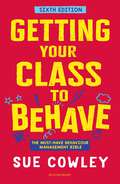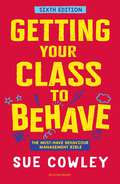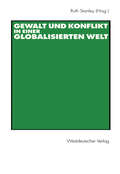- Table View
- List View
Getting Tough: Welfare and Imprisonment in 1970s America
by Julilly Kohler-HausmannThe politics and policies that led to America's expansion of the penal system and reduction of welfare programsIn 1970s America, politicians began "getting tough" on drugs, crime, and welfare. These campaigns helped expand the nation's penal system, discredit welfare programs, and cast blame for the era's social upheaval on racialized deviants that the state was not accountable to serve or represent. Getting Tough sheds light on how this unprecedented growth of the penal system and the evisceration of the nation's welfare programs developed hand in hand. Julilly Kohler-Hausmann shows that these historical events were animated by struggles over how to interpret and respond to the inequality and disorder that crested during this period.When social movements and the slowing economy destabilized the U.S. welfare state, politicians reacted by repudiating the commitment to individual rehabilitation that had governed penal and social programs for decades. In its place, they championed strategies of punishment, surveillance, and containment. The architects of these tough strategies insisted they were necessary, given the failure of liberal social programs and the supposed pathological culture within poor African American and Latino communities. Kohler-Hausmann rejects this explanation and describes how the spectacle of enacting punitive policies convinced many Americans that social investment was counterproductive and the "underclass" could be managed only through coercion and force.Getting Tough illuminates this narrative through three legislative cases: New York's adoption of the 1973 Rockefeller drug laws, Illinois's and California's attempts to reform welfare through criminalization and work mandates, and California's passing of a 1976 sentencing law that abandoned rehabilitation as an aim of incarceration. Spanning diverse institutions and weaving together the perspectives of opponents, supporters, and targets of punitive policies, Getting Tough offers new interpretations of dramatic transformations in the modern American state.
Getting Tough: Welfare and Imprisonment in 1970s America
by Julilly Kohler-HausmannThe politics and policies that led to America's expansion of the penal system and reduction of welfare programsIn 1970s America, politicians began "getting tough" on drugs, crime, and welfare. These campaigns helped expand the nation's penal system, discredit welfare programs, and cast blame for the era's social upheaval on racialized deviants that the state was not accountable to serve or represent. Getting Tough sheds light on how this unprecedented growth of the penal system and the evisceration of the nation's welfare programs developed hand in hand. Julilly Kohler-Hausmann shows that these historical events were animated by struggles over how to interpret and respond to the inequality and disorder that crested during this period.When social movements and the slowing economy destabilized the U.S. welfare state, politicians reacted by repudiating the commitment to individual rehabilitation that had governed penal and social programs for decades. In its place, they championed strategies of punishment, surveillance, and containment. The architects of these tough strategies insisted they were necessary, given the failure of liberal social programs and the supposed pathological culture within poor African American and Latino communities. Kohler-Hausmann rejects this explanation and describes how the spectacle of enacting punitive policies convinced many Americans that social investment was counterproductive and the "underclass" could be managed only through coercion and force.Getting Tough illuminates this narrative through three legislative cases: New York's adoption of the 1973 Rockefeller drug laws, Illinois's and California's attempts to reform welfare through criminalization and work mandates, and California's passing of a 1976 sentencing law that abandoned rehabilitation as an aim of incarceration. Spanning diverse institutions and weaving together the perspectives of opponents, supporters, and targets of punitive policies, Getting Tough offers new interpretations of dramatic transformations in the modern American state.
Getting Unstuck: Using Leadership Paradox to Execute with Confidence
by Ralph JacobsonHumans are naturally wired to solve problems. Implement the right solutions and the problems generally go away. Paradoxes are quite different. They consist of opposites that do not appear to be able to coexist, but must. Most of the issues that keep organizations from achieving strategic success are not problems, they are paradoxes. Practical appro
Getting Welfare to Work: Street-Level Governance in Australia, the UK, and the Netherlands
by Mark Considine Jenny M. Lewis Siobhan O'Sullivan Els SolGetting Welfare to Work traces the radical reform of the Australian, UK, and Dutch public employment services systems. Starting with major changes from 1998, this book examines how each national system has moved from traditional public services towards more privately provided and market-based methods. Each of these three countries developed innovative forms of contracting-out and complex incentive regimes to motivate welfare clients and to control the agencies charged with helping them. The Australian system pioneered the use of large, national contracts for services to all unemployed jobseekers. By the end of our study period this system was entirely outsourced to private agencies. Meanwhile the UK elected a form of contestability under Blair and Cameron, culminating in a new public-private financing model known as the 'Work Programme'. The Dutch had evolved their far more complex system from a traditional public service approach to one using a variety of specific contracts for private agencies. These innovations have changed welfare delivery and created both opportunities and new constraints for policy makers. Getting Welfare to Work tells the story of these bold policy reforms from the perspective of street-level bureaucrats. Interviews and surveys in each country over a fifteen year period are used to critically appraise this central pillar of the welfare state. The original data analysed in Getting Welfare to Work provides a unique comparative perspective on three intriguing systems. It points to new ways of thinking about modes of governance, system design, regulation of public services, and so-called activation of welfare clients. It also sheds light on the predicament of third sector organisations that contract to governments through competitive tenders with precise performance monitoring, raising questions of 'mission drift'.
Getting Your Child Back to School: A Parent's Guide to Solving School Attendance Problems, Revised and Updated Edition
by Christopher A. KearneyA collection of accessible and scientifically proven strategies for parents struggling with school attendance problems in children of all ages. School attendance problems are a common and worrisome challenge faced by many parents. Even in milder forms, poor school attendance can increase the risk of social, behavioral, and academic problems in childhood and adolescence, and even into adulthood. Unfortunately, parents often have trouble understanding their children's school attendance issues and are uncertain about how to help. Getting Your Child Back to School is intended for parents grappling with school attendance problems at the elementary, middle, and high school levels. Covering a wide variety of attendance problems and special circumstances, the book offers practical, step-by-step strategies parents can use themselves, including asking the right questions, evaluating the severity of the problem, and knowing whom to consult. Parents will learn to change a child's negative thoughts around school, establish a clear and predictable morning routine, and set up a system of rewards for going to school. New to this edition is material on very severe and chronic cases, including discussion of educational alternatives; mindfulness approaches and parent involvement strategies; teletherapy and other options for young people who have been out of school for an extended period; and more extensive guidance on working with school officials. Easy to read and filled with concrete strategies, this book was the first of its kind dedicated to educating and arming parents with the tools they need to resolve their children's absenteeism; this new edition continues to offer the best available scientifically-proven guidance for parents determined to get their kids back to school.
Getting Your Child Back to School: A Parent's Guide to Solving School Attendance Problems, Revised and Updated Edition
by Christopher A. KearneyA collection of accessible and scientifically proven strategies for parents struggling with school attendance problems in children of all ages. School attendance problems are a common and worrisome challenge faced by many parents. Even in milder forms, poor school attendance can increase the risk of social, behavioral, and academic problems in childhood and adolescence, and even into adulthood. Unfortunately, parents often have trouble understanding their children's school attendance issues and are uncertain about how to help. Getting Your Child Back to School is intended for parents grappling with school attendance problems at the elementary, middle, and high school levels. Covering a wide variety of attendance problems and special circumstances, the book offers practical, step-by-step strategies parents can use themselves, including asking the right questions, evaluating the severity of the problem, and knowing whom to consult. Parents will learn to change a child's negative thoughts around school, establish a clear and predictable morning routine, and set up a system of rewards for going to school. New to this edition is material on very severe and chronic cases, including discussion of educational alternatives; mindfulness approaches and parent involvement strategies; teletherapy and other options for young people who have been out of school for an extended period; and more extensive guidance on working with school officials. Easy to read and filled with concrete strategies, this book was the first of its kind dedicated to educating and arming parents with the tools they need to resolve their children's absenteeism; this new edition continues to offer the best available scientifically-proven guidance for parents determined to get their kids back to school.
Getting Your Class to Behave: The must-have behaviour management bible
by Ms Sue CowleySue Cowley's bestselling behaviour guide is back, updated and better than ever. 'Day after day, you arrive at your job, only to face students who simply will not behave. You begin to dread coming into work, knowing that you have to face such a difficult day… What can you do? First, read this book.'In this brand new edition, Sue takes a detailed look at positive behaviour management, considers recent advances in understanding self-regulation, and offers specific advice on tackling behavioural challenges in the post-Covid classroom. Getting Your Class to Behave is the positive, practical answer to poor behaviour you've been looking for!The latest and greatest edition of the classic Getting the Buggers to Behave, this behaviour management bible has long been a firm favourite with trainees, early career teachers and experienced staff alike. The advice ranges from the basics of behaviour management to how to deal with any tricky class and is applicable whether you are working in the early years, primary, secondary or further education. Sue offers honest, straightforward support with case studies, anecdotes and level-specific examples in every chapter. Sue knows that no matter how much passion and care you have for the job, there's no match for poor behaviour like tried-and-tested techniques. If your two-year-olds are ignoring you, your Year 11s are distracted, or your tutor group is not-so-quietly chaotic then this is the book for you!
Getting Your Class to Behave: The must-have behaviour management bible
by Ms Sue CowleySue Cowley's bestselling behaviour guide is back, updated and better than ever. 'Day after day, you arrive at your job, only to face students who simply will not behave. You begin to dread coming into work, knowing that you have to face such a difficult day… What can you do? First, read this book.'In this brand new edition, Sue takes a detailed look at positive behaviour management, considers recent advances in understanding self-regulation, and offers specific advice on tackling behavioural challenges in the post-Covid classroom. Getting Your Class to Behave is the positive, practical answer to poor behaviour you've been looking for!The latest and greatest edition of the classic Getting the Buggers to Behave, this behaviour management bible has long been a firm favourite with trainees, early career teachers and experienced staff alike. The advice ranges from the basics of behaviour management to how to deal with any tricky class and is applicable whether you are working in the early years, primary, secondary or further education. Sue offers honest, straightforward support with case studies, anecdotes and level-specific examples in every chapter. Sue knows that no matter how much passion and care you have for the job, there's no match for poor behaviour like tried-and-tested techniques. If your two-year-olds are ignoring you, your Year 11s are distracted, or your tutor group is not-so-quietly chaotic then this is the book for you!
Getting Your People to Step Up: 7 Simple Strategies to Attract and Keep Your Key Talent
by Shivani GuptaA roadmap for hiring, coaching and motivating top performers In business, your people are your most important asset. But finding, training and motivating the right people can be daunting and costly. If you want to keep your best employees — and grow your business with their support — then Getting Your People to Step Up is the book for you! Business coach Shivani Gupta reveals seven proven strategies to help you recruit top talent and ensure your employees are happier, more engaged and more productive. Getting Your People to Step Up offers a no-nonsense approach to hiring, managing and empowering your staff. You’ll learn how to coach your team and be a leader who inspires growth and loyalty. When the right employees are highly engaged and performing, running your business is not only more profitable: it becomes fun! Get strategies to recruit and incentivise the best people Combat employee burnout and prevent high turnover Transform your leadership style and coach for success Create a shared vision for your business that unites your team and fosters collaboration Communicate more effectively to set expectations and deliver feedback for growth Create a positive work environment with a culture of diversity and inclusion Don’t hire fast and fire faster. Avoid costly mistakes: find the right person for the job, and enable them to thrive. With Getting Your People to Step Up, you’ll learn how to unlock the long-term potential of your team so that your business can truly flourish.
Getting Your People to Step Up: 7 Simple Strategies to Attract and Keep Your Key Talent
by Shivani GuptaA roadmap for hiring, coaching and motivating top performers In business, your people are your most important asset. But finding, training and motivating the right people can be daunting and costly. If you want to keep your best employees — and grow your business with their support — then Getting Your People to Step Up is the book for you! Business coach Shivani Gupta reveals seven proven strategies to help you recruit top talent and ensure your employees are happier, more engaged and more productive. Getting Your People to Step Up offers a no-nonsense approach to hiring, managing and empowering your staff. You’ll learn how to coach your team and be a leader who inspires growth and loyalty. When the right employees are highly engaged and performing, running your business is not only more profitable: it becomes fun! Get strategies to recruit and incentivise the best people Combat employee burnout and prevent high turnover Transform your leadership style and coach for success Create a shared vision for your business that unites your team and fosters collaboration Communicate more effectively to set expectations and deliver feedback for growth Create a positive work environment with a culture of diversity and inclusion Don’t hire fast and fire faster. Avoid costly mistakes: find the right person for the job, and enable them to thrive. With Getting Your People to Step Up, you’ll learn how to unlock the long-term potential of your team so that your business can truly flourish.
Getting Your Way: Strategic Dilemmas in the Real World
by James M. JasperGetting other people to do what we want is a useful skill for anyone. Whether you’re seeking a job, negotiating a deal, or angling for that big promotion, you’re engaged in strategic thought and action. In such moments, you imagine what might be going on in another person’s head and how they’ll react to what you do or say. At the same time, you also try to pick the best way to realize your goals, both with and without the other person’s cooperation. Getting Your Way teaches us how to win that game by offering a fuller understanding of how strategy works in the real world. As we all know, rules of strategy are regularly discovered and discussed in popular books for business executives, military leaders, and politicians. Those works with their trendy lists of pithy maxims and highly effective habits can help people avoid mistakes or even think anew about how to tackle their problems. But they are merely suggestive, as each situation we encounter in the real world is always more complex than anticipated, more challenging than we had hoped. James M. Jasper here shows us how to anticipate those problems before they actually occur—by recognizing the dilemmas all strategic players must negotiate, with each option accompanied by a long list of costs and risks. Considering everyday dilemmas in a broad range of familiar settings, from business and politics to love and war, Jasper explains how to envision your goals, how to make the first move, how to deal with threats, and how to employ strategies with greater confidence. Alexander the Great, Genghis Khan, Rosa Parks, Hugo Chávez, and David Koresh all come into play in this smart and engaging book, one that helps us recognize and prepare for the many dilemmas inherent in any strategic action.
Getting Your Way: Strategic Dilemmas in the Real World
by James M. JasperGetting other people to do what we want is a useful skill for anyone. Whether you’re seeking a job, negotiating a deal, or angling for that big promotion, you’re engaged in strategic thought and action. In such moments, you imagine what might be going on in another person’s head and how they’ll react to what you do or say. At the same time, you also try to pick the best way to realize your goals, both with and without the other person’s cooperation. Getting Your Way teaches us how to win that game by offering a fuller understanding of how strategy works in the real world. As we all know, rules of strategy are regularly discovered and discussed in popular books for business executives, military leaders, and politicians. Those works with their trendy lists of pithy maxims and highly effective habits can help people avoid mistakes or even think anew about how to tackle their problems. But they are merely suggestive, as each situation we encounter in the real world is always more complex than anticipated, more challenging than we had hoped. James M. Jasper here shows us how to anticipate those problems before they actually occur—by recognizing the dilemmas all strategic players must negotiate, with each option accompanied by a long list of costs and risks. Considering everyday dilemmas in a broad range of familiar settings, from business and politics to love and war, Jasper explains how to envision your goals, how to make the first move, how to deal with threats, and how to employ strategies with greater confidence. Alexander the Great, Genghis Khan, Rosa Parks, Hugo Chávez, and David Koresh all come into play in this smart and engaging book, one that helps us recognize and prepare for the many dilemmas inherent in any strategic action.
Getting Your Way: Strategic Dilemmas in the Real World (Phoenix Fiction Ser.)
by James M. JasperGetting other people to do what we want is a useful skill for anyone. Whether you’re seeking a job, negotiating a deal, or angling for that big promotion, you’re engaged in strategic thought and action. In such moments, you imagine what might be going on in another person’s head and how they’ll react to what you do or say. At the same time, you also try to pick the best way to realize your goals, both with and without the other person’s cooperation. Getting Your Way teaches us how to win that game by offering a fuller understanding of how strategy works in the real world. As we all know, rules of strategy are regularly discovered and discussed in popular books for business executives, military leaders, and politicians. Those works with their trendy lists of pithy maxims and highly effective habits can help people avoid mistakes or even think anew about how to tackle their problems. But they are merely suggestive, as each situation we encounter in the real world is always more complex than anticipated, more challenging than we had hoped. James M. Jasper here shows us how to anticipate those problems before they actually occur—by recognizing the dilemmas all strategic players must negotiate, with each option accompanied by a long list of costs and risks. Considering everyday dilemmas in a broad range of familiar settings, from business and politics to love and war, Jasper explains how to envision your goals, how to make the first move, how to deal with threats, and how to employ strategies with greater confidence. Alexander the Great, Genghis Khan, Rosa Parks, Hugo Chávez, and David Koresh all come into play in this smart and engaging book, one that helps us recognize and prepare for the many dilemmas inherent in any strategic action.
Gewalt – Vernunft – Angst: Interdisziplinäre Zugänge und theoretische Annäherungen
by Jutta Ecarius Johannes BilsteinDas Buch geht der Frage nach, welche Bedeutung Angst und Vernunft im Kontext von kultureller Gewaltförmigkeit und subjektiver unterschiedlicher Gewalterfahrungen zukommen. Sozialwissenschaftliche, erziehungsphilosophische und kulturwissenschaftliche Perspektiven erschließen einen interdisziplinären Zugang zu Gewalt von Kultur und Medien, der Erfahrung von Angst und Vulnerabilität sowie von Fremdheit und Wut.
Gewalt an Schulen: 1994 - 1999 - 2004
by Marek Fuchs Siegfried Lamnek Jens Luedtke Nina BaurImmer wieder kommt die Rede auf Fälle schwerer Gewalt von Schülern, wobei in jüngerer Zeit gerade Beispiele von Gewalt gegen Lehrer die Runde machen. Wie sieht aber abseits dieser brutalen Einzelfälle die Gewaltlage an Schulen aus und vor allem: Wie hat sie sich über einen längeren Zeitraum entwickelt? Nach den Wellen von 1994 und 1999 wurde 2004 zum dritten Mal mit einer repräsentativen Befragung von 4.523 Schülern die Gewaltsituation an allgemein- und berufsbildenden Schulen erhoben. Die Studie kann damit als eine der wenigen verlässliche Angaben zur Gewaltentwicklung über einen 10-Jahres-Zeitraum machen.
Gewalt durch Gewalt im Fernsehen?
by Klaus MertenDie Prüfung der These von der "Gewalt durch Gewalt im Fernsehen" ist Gegenstand der vorliegenden Untersuchung. Dabei werden alle relevanten Theorieansätze hierzu vorgestellt und kritisch durchgemustert. Das Ergebnis ist mehr als überraschend und entlarvt die bislang öffentlich geführte Diskussion über die angeblich medienerzeugte Gewalt als einen zyklisch erneuerbaren, aber fruchtlosen Diskurs, dessen wissenschaftlicher Gehalt über weite Strecken durch die dadurch entfachte öffentliche Diskussion substituierbar erscheint. Ideologie und anderes ist am Werk, denn: Je weniger wissenschaftlich die Prüfung der Frage nach der "Gewalt durch Gewalt im Fernsehen?" geführt wird, umso größer erscheinen die von den Medien drohenden und prognostizierten Gefahren
Gewalt im sozialen Nahraum: Die Logik von Prävention in ländlichen Sozialräumen
by Manuela BrandstetterGewalt in den Anden: Systemtheoretische Überlegungen zu Gewaltstrukturen in Kolumbien (Innovative Konfliktforschung – Innovation in Conflict Research)
by Bettina M.E. BenzingDas Buch beschäftigt sich mit den langfristigen sozialstrukturellen Auswirkungen von Gewaltkonflikten in Postkonfliktgesellschaften, eines der aktuellsten Forschungsthemen der Friedens- und Konfliktforschung. Basierend auf empirischer Forschung in verschiedenen Landesteilen Kolumbiens wird argumentiert, dass sich die unter Gewalteinfluss entstandenen Sozialstrukturen primär durch Misstrauensmechanismen in der Gesellschaft auszeichnen, wodurch sich einerseits Gewalt als Kommunikationsmuster auch nach Friedensschlüssen weiter erhält und reproduziert sowie andererseits sich exkludierende Strukturen für marginalisierte Bevölkerungsteile ausbilden, die einem Frieden nachhaltig entgegenwirken. Mittels eines systemtheoretischen Ansatzes macht das Buch daher ein Angebot zum besseren Verständnis anhaltender Gewalt in Postkonfliktgesellschaften.
Gewalt in öffentlichen Räumen: Zum Einfluss von Bevölkerungs- und Siedlungsstrukturen in städtischen Wohnquartieren
by Wilhelm Heitmeyer Helmut ThomeDass die „Integrationsmaschine Stadt” gegenwärtig einer harten Belastungsprobe ausgesetzt ist und dass die soziale Stadt immer größere Regulierungsprobleme zu bewältigen hat, gilt weitestgehend als unstrittig. Es wird offenbar schwieriger, das schon immer zerbrechliche Verhältnis von städtischer Integration und Desintegration ohne größere innere und äußere Schäden in einer tragbaren Balance zu halten. So gibt es verschiedene Anhaltspunkte dafür, dass es nicht unbedingt die unmittelbare physische Gewalt ist, die im öffentlichen Raum verstärkt zum Ausbruch kommt und damit auffällig wird, sondern dass das Potential für Gewaltbilligung bzw. -bereitschaft bereits in der Struktur des sozialen Zusammenlebens angelegt sein kann.
Gewalt in öffentlichen Räumen: Zum Einfluss von Bevölkerungs- und Siedlungsstrukturen in städtischen Wohnquartieren
by Wilhelm Heitmeyer Helmut ThomeDass die „Integrationsmaschine Stadt” gegenwärtig einer harten Belastungsprobe ausgesetzt ist und dass die soziale Stadt immer größere Regulierungsprobleme zu bewältigen hat, gilt weitestgehend als unstrittig. Es wird offenbar schwieriger, das schon immer zerbrechliche Verhältnis von städtischer Integration und Desintegration ohne größere innere und äußere Schäden in einer tragbaren Balance zu halten. So gibt es verschiedene Anhaltspunkte dafür, dass es nicht unbedingt die unmittelbare physische Gewalt ist, die im öffentlichen Raum verstärkt zum Ausbruch kommt und damit auffällig wird, sondern dass das Potential für Gewaltbilligung bzw. -bereitschaft bereits in der Struktur des sozialen Zusammenlebens angelegt sein kann.
Gewalt sei ferne den Dingen!: Contemporary Perspectives on the Works of John Amos Comenius
by Wouter Goris Meinert A. Meyer Vladimír UrbánekComenius (1592 - 1670) war ein großer Europäer, ein kreativer Metaphysiker und überzeugter, aber nicht indoktrinierender Theologe, ein Pädagoge, der zugleich ein begnadeter Praktiker war, ein Politiktheoretiker, ein Literat und Linguist auf hohem Niveau. Der Wunsch, Gewalt von den Dingen fernzuhalten, stammt von ihm. Er wird verständlich, wenn man sich klar macht, dass Comenius „pansophisch“ (allumfassend) gedacht hat: Die Gewalt gegen die Dinge spiegelt die Gewalt gegen die Menschen, und beides muss aufhören. Die vorliegende Publikation zeigt eine fremde Welt, die doch in unserer Zeit angesichts der Globalisierung aller Lebensbereiche wieder von großer Aktualität ist. Comenius fostered pansophic, all-encompassing thinking in philosophy, theology, history, politics and education. That is why today, in an age of increased globalisation, his works are the subject of renewed interest. Twenty-nine authors from eight countries, dedicated to this task, develop the picture of a great European thinker.
Gewalt und Fremdenfeindlichkeit jugendpädagogische Auswege: Fünf Modellprojekte im Hessischen Jugendaktionsprogramm gegen Gewalt, Fremdenfeindlichkeit und Rechtsextremismus. Werkstattbericht
by Christina Klose Helmolt Rademacher Benno Hafeneger Mechthild JansenGewalttätiges Auftreten Jugendlicher in der Öffentlichkeit, fremdenfeindliche Parolen und Taten sowie eine steigende Akzeptanz rechtsextremen Gedankenguts sind ein besorgniserregendes Alarmsignal, auf das in Hessen fünf Modellprojekte reagierten, indem sie exemplarisch Wege aus der Verstrickung von Randale und No-future-Gefühl aufzeigten. Die von einer unabhängigen Fachjury ausgewählten Projekte erreichten unterschiedliche Zielgruppen: "rechte" Jungen, randständige Cliquen unterschiedlicher Nationalitäten, schwierige Schulklassen, von Gewalt bedrohte Mädchen und junge Frauen, TäterInnen und Opfer. Besondere Aufmerksamkeit galt den geschlechtsspezifischen Unterschieden sowohl bei der aktiven Beteiligung an Gewalttaten, des impliziten Gewinns bei der MittäterInnenschaft und der unterschiedlichen Betroffenheit durch erlittene Gewalttaten bei Mädchen und Jungen.
Gewalt und Konflikt in einer globalisierten Welt: Festschrift für Ulrich Albrecht
by Ruth StanleyNach dem Ende des Ost-West-Konflikts und den epochalen Umbrüchen in Ost- und Ostmitteleuropa ist die Welt keineswegs friedlicher geworden. Vielmehr verdichten sich die Hinweise auf Verdrehungen und Verwerfungen von Konfliktachsen. Auch lässt die offensichtliche Kluft der wirtschaftlichen, sozialen und kulturellen Entwicklung in den verschiedenen Regionen der Welt ernsthafte Zweifel am weltgesellschaftlichen Mehrwert der Globalisierung erwachsen. Der vorliegende Band - eine Festschrift zum 60. Geburtstag von Ulrich Albrecht - widmet sich vor allem den Konflikten, die in der globalisierten Welt letzthin entstanden sind, sowie dem Problem der Gewalt, das in vielerlei Gestalt die Globalisierung begleitet. Autorinnen und Autoren aus dem In- und Ausland analysieren Facetten der neuen globalen Konflikttypen, Zivilisierungstendenzen und Gewaltformen und erörtern Handlungsmöglichkeiten der Einhegung von Gewalt und Konflikten.
Gewalt- und Krisenprävention in Beruf und Alltag: Ursachen und Lösungen für Gewalt und Krisen
by Rudi Heimann Jürgen FritzscheDer Herausgeberband gibt einen anwenderorientierten Überblick zu Ursachen und Entwicklungen von Bedrohungen, Gewalt und daraus entstehender Krisen im beruflichen Kontext und im Alltag. Ein interdisziplinäres Autorenteam stellt neben den Grundlagen die wichtigsten Methoden zur Bewältigung sich entwickelnder und bereits offener Gewalt- und Krisensituationen vor. Der Schwerpunkt liegt im Anwendungsteil auf angemessener konfliktfreier Lösung und der konsequenten Verfolgung alternativer Möglichkeiten, wenn eine konfliktfreie Bewältigung nicht mehr möglich ist. Sicherheitskonzepten und praktikablen Deeskalationsmodellen wird ebenso wie massiven Krisen ein Platz eingeräumt.Die Zielgruppen sind Führungskräfte und Mitarbeitende in öffentlichen Verwaltungen, Justiz, Schulen, Geldinstituten, im Gesundheitswesen, öffentlichen Personennahverkehr oder in vergleichbaren Einrichtungen, Verantwortliche wie Sicherheits- und Präventionsbeauftragte in diesen Bereichen, Trainer für Sicherheitsthemen und Interessierte im privaten Umfeld.Die Herausgeber sind Rudi Heimann, Leitender Polizeidirektor, Experte für Gewaltschutz und Krisenbewältigung, Keynote Speaker und Leiter einer Zentralen Ausländerbehörde, sowieDr. Jürgen Fritzsche, sportwissenschaftlicher Berater, Coach und Gewaltschutztrainer (EXperts for TRAining), ehemaliger Bundeslehrwart des Deutschen Karateverbandes, international tätiger Dozent und Technischer Direktor des luxemburgischen Karateverbandes.Empfehlung der DGUV“Im vorliegenden Buch ist es gelungen, die aktuellen Erkenntnisse zum Thema Gewalt umfassend und gleichzeitig alltagsnah aufzubereiten. Eine besondere Stärke liegt in der Interdisziplinarität […], die Einblicke in verschiedenste wissenschaftliche Bereiche gewährt. Klare Handlungsempfehlungen schützen bei einem potentiell gewalttätigen Konflikt vor einer weiteren Eskalation.”Dr. Stefan HussyHauptgeschäftsführer der Deutschen Gesetzlichen Unfallversicherung (DGUV)
Gewalterfahrungen gehörloser Frauen: Risikofaktoren, Ressourcen und gesundheitliche Folgen (Sozialer Wandel und Kohäsionsforschung)
by Sabine FriesDie Erkenntnis, dass gehörlose Frauen von verschiedenen Formen von Gewalt und ihren Folgen genauso oder sogar weit häufiger betroffen sein können als andere Frauen, ist in der Öffentlichkeit kaum bekannt. Ein stark erhöhtes Risiko für Gewalterfahrungen ergibt sich bei gehörlosen Frauen vor allem aufgrund einer ausgeprägten gesellschaftlichen Isolation. Ein weiterer wesentlicher Risikofaktor für die im Vergleich zu Frauen mit und ohne Behinderungen überdurchschnittlich hohe Gewaltbetroffenheit gehörloser Frauen ist ihre häufig alternativlose Einbindung in die Gehörlosengemeinschaft. Dies verweist darauf, dass unsere Gesellschaft bislang daran gescheitert ist, gehörlose Menschen ausreichend zu integrieren, und diese so marginalisiert hat, dass sie von der Mehrheitsgesellschaft weitgehend unbemerkt zu Tätern und Opfern werden. Nicht zuletzt hat Gewalt gegen gehörlose Frauen komplexe und weitreichende gesundheitliche Folgen. Das Gesundheitssystem nimmt deshalb eine Schlüsselrolle für die Prävention, Weitervermittlung und Intervention bei Gewalt gegen gehörlose Frauen und ihre Kinder ein.



















